Chess
Tuesday, October 13, 2009

CHESS IS A board game and mental sport for two players. It is played on a square board of 8 rows (called ranks) and 8 columns (called files), giving 64 squares of alternating colour, light and dark, with each player having a light square at his bottom right when facing the board.
Each player begins the game with 16pieces that each move and capture other pieces on the board in a unique way: eight pawns, two knights, two bishops, two rooks, one queen and one king.
Checkmate: This is the English rendition of shah mat, which is Persian for "the king is finished".
Rook: From Sanskrit Rath which means "chariot", or Persian rukh which means "chariot" or "cheek" (part of the face). The piece resembles a siege tower. It is also believed to be named after the mythical Persian bird of great power called the roc. In India, the piece is more popularly called haathi, which means "elephant".
Bishop: From the Persian pil ("the elephant"), but in Europe and the western part of the Islamic world people knew little or nothing about elephants (curiously, in Russia this piece is called slon, which is Russian for "elephant"). The name of the chessman entered Western Europe as Latin alfinus, a meaningless word that then evolved further (in Spanish, for example, it evolved to the name "alfil"); alfil is actually Arabic for "the elephant", where al means "the" and fil means "elephant". The Spanish word would most certainly have been taken from the Islamic provinces of Spain. The English name "bishop" is inspired by the conventional shape of the piece originally intended as the tusk of an elephant but which also looks like the mitre of a bishop.
Queen: Persian farzin ("vizier") became Arabic firzan, which entered western European languages in such forms as alfferza and fers, but was later replaced by "queen". "Fers" persists as a commonly-used alternate name for the piece in Russia.

0 comments:
Post a Comment